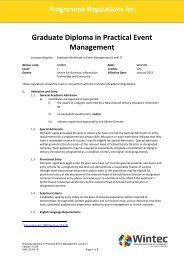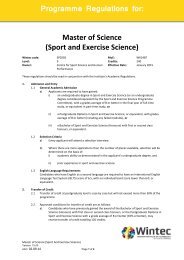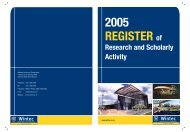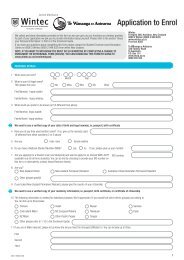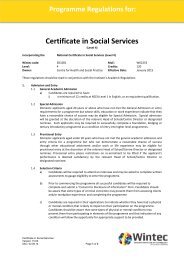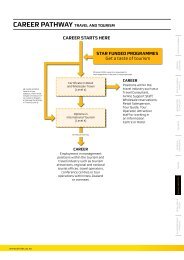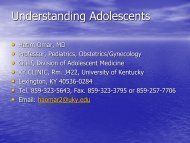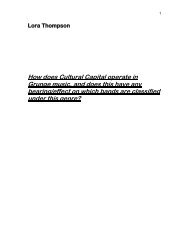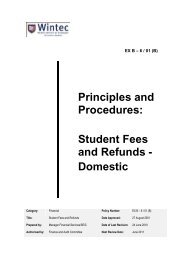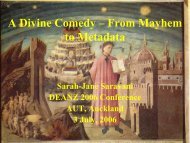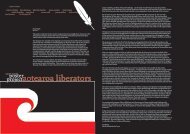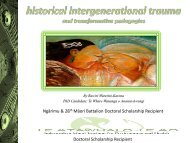2012 wintec annual report
2012 wintec annual report
2012 wintec annual report
You also want an ePaper? Increase the reach of your titles
YUMPU automatically turns print PDFs into web optimized ePapers that Google loves.
NOTES TO THE<br />
FINANCIAL STATEMENTS<br />
For the year ended 31 December <strong>2012</strong>.<br />
1 REPORTING ENTITY<br />
The Waikato Institute of Technology (the Institute) is a Tertiary<br />
Education Institution (TEI) domiciled in New Zealand and is<br />
governed by the Crown Entities Act 2004 and the Education Act<br />
1989. It provides full-time and part-time tertiary education in<br />
New Zealand.<br />
The consolidated financial statements include the following<br />
subsidiaries: SODA Inc. Limited, and the Wintec Foundation Trust.<br />
These entities are all incorporated in New Zealand. Refer to note<br />
24 for further details of all entities included in the Group.<br />
The primary objective of the Institute and Group is to provide<br />
tertiary education services for the benefit of the community rather<br />
than making a financial return. Accordingly, the Institute has<br />
designated itself and the Group as public benefit entities for the<br />
purposes of New Zealand equivalents to International Financial<br />
Reporting Standards (NZIFRS).<br />
The financial statements of the Institute for the year ended<br />
31 December <strong>2012</strong> were authorised for issue in accordance with<br />
a resolution of the Councillors on 23 April 2013. Council does not<br />
have the power to amend the statements after issue.<br />
Basis of preparation<br />
Statement of compliance<br />
The financial statements of the Institute and Group have been<br />
prepared in accordance with the requirements of the Crown<br />
Entities Act 2004 and the Education Act 1989, which include the<br />
requirement to comply with New Zealand generally accepted<br />
accounting practice (NZ GAAP).<br />
These financial statements have been prepared in accordance<br />
with NZ GAAP and comply with NZ IFRS, as appropriate for public<br />
benefit entities.<br />
Measurement basis<br />
The financial statements have been prepared on a historical cost<br />
basis, except for investment properties, assets classified as held<br />
for sale and land and buildings that have been measured at<br />
fair value.<br />
Functional and presentation currency<br />
The financial statements are presented in New Zealand dollars and<br />
all values are rounded to the nearest thousand dollars ($’000).<br />
The functional currency of the Institute and Group is New Zealand<br />
dollars (NZ $).<br />
Changes in accounting policies<br />
There have been no changes in accounting policies during the<br />
financial year.<br />
The Institute has adopted the following revisions to accounting<br />
standards during the financial year, which have had only a<br />
presentational or disclosure effect.<br />
FRS-44 New Zealand Additional Disclosures and Amendments to NZ<br />
IFRS to harmonise with IFRS and Australian Accounting Standards<br />
(Harmonisation Amendments) – The purpose of the new standard<br />
and amendments is to harmonise Australian and New Zealand<br />
accounting standards with source IFRS and to eliminate many of the<br />
differences between the accounting standards in each jurisdiction.<br />
The main effect of the amendments on the Institute is that<br />
donations are no longer required to be separately disclosed and<br />
certain information about property valuations is no longer required<br />
to be disclosed. Note 8 has been updated for these changes.<br />
Standards, amendments, and interpretations that are not yet<br />
effective and have not been early adopted<br />
Standards, amendments, and interpretations issued but not yet<br />
effective that have not been early adopted, and are relevant to the<br />
Institute and Group, are:<br />
NZ IFRS 9 Financial Instruments will eventually replace NZ IAS 39<br />
Financial Instruments: Recognition and Measurement. NZ IAS<br />
39 is being replaced through the following three main phases:<br />
Phase 1 Classification and Measurement, Phase 2 Impairment<br />
Methodology, and Phase 3 Hedge Accounting. Phase 1 has<br />
been completed and has been published in the new financial<br />
instrument standard NZ IFRS 9. NZ IFRS 9 uses a single approach<br />
to determine whether a financial asset is measured at amortised<br />
cost or fair value, replacing the many different rules in NZ IAS 39.<br />
The approach in NZ IFRS 9 is based on how an entity manages its<br />
financial assets (its business model) and the contractual cash<br />
flow characteristics of the financial assets. The financial liability<br />
requirements are the same as those of NZ IAS 39, except for<br />
when an entity elects to designate a financial liability at fair value<br />
through the surplus or deficit. The new standard is required to



